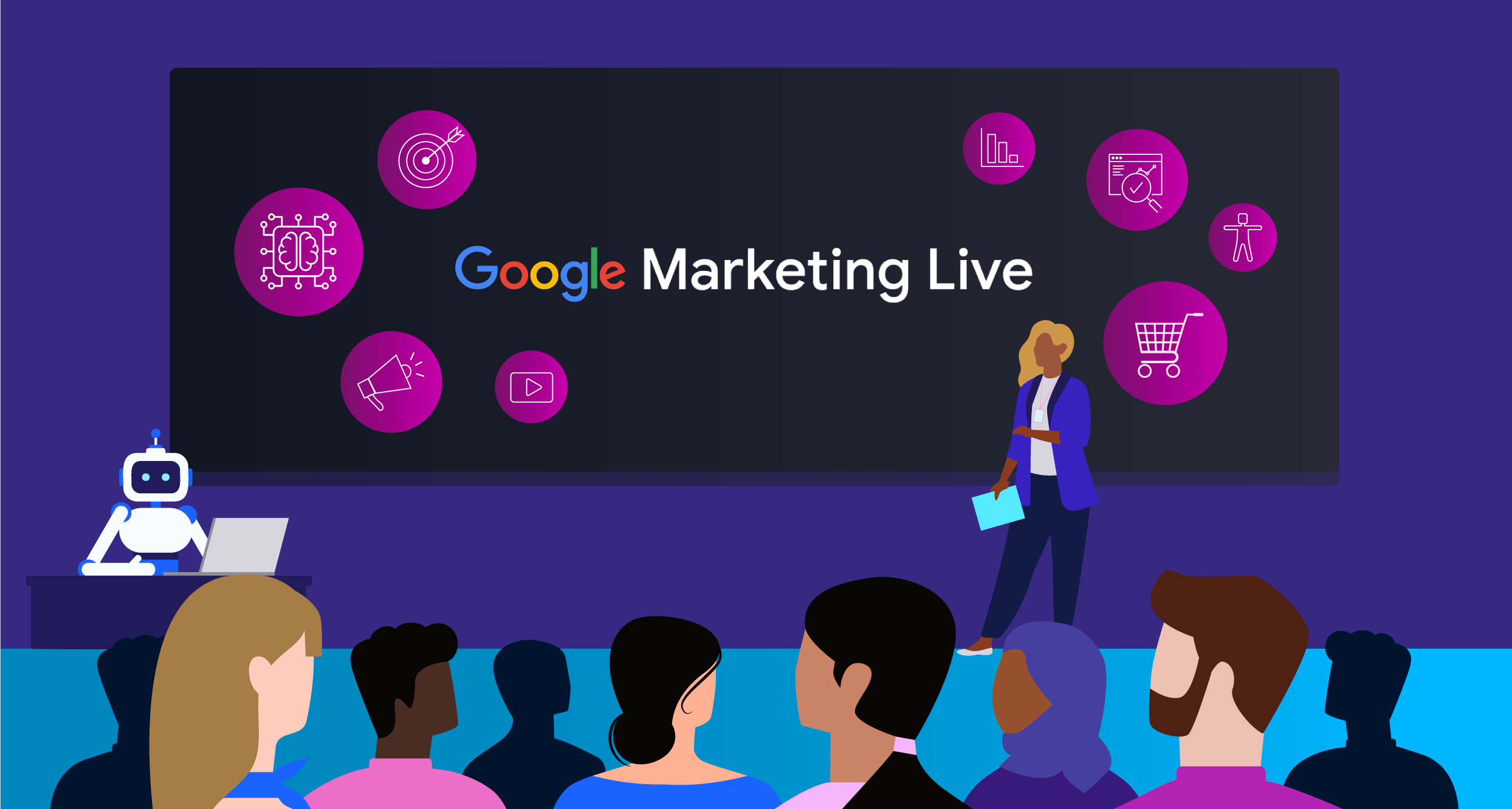Google’s Big Bet: How AI in Marketing Means Success Belongs to the Strategic and The Bold

While Google embraces the AI-driven future of digital marketing and advertising, the future will ultimately be won by brands that dare to test and learn across toolsets, and that embrace change through meaningful analysis. While tools can make marketing more efficient, building organizational understanding and leadership buy-in are critical to transforming marketing’s impact on an organization.
If you happened to catch wind of the product debuts and news from Google’s Marketing Live (GML) 2023 last month, it was hard to ignore the overarching theme of how Google is leveraging AI to make marketing easier, more cost-effective, and more accessible. Google’s position is that AI can help marketers generate greater customer connections, creativity, and confidence in our marketing. While there is no shortage of posts dedicated to the 20 new product debuts, our main takeaway from GML was that as the landscape for digital media becomes more AI-driven, AI-empowered tools can make marketing a profit center for businesses.
The Consumer-Directed Marketing Funnel
Despite offering video, banner, search, and shopping placements that look the part of integrated marketing funnel tactics, it hasn’t always been obvious how these work in concert to facilitate a user’s journey and actually pull users through the funnel—as opposed to simply messaging different people on different placements. By combining some of the tooling and features (such as Video View campaigns) debuted at GML last month, Google is showing its hand towards the future of journey orchestration, from the first six-second YouTube video someone might see in passing, to measurable site experiences on GA4.
New video view campaigns can incorporate creative scaling functionality for vertical video (for YouTube Shorts), and demand gen campaigns can generate and capture engagement across placements, with enhanced targeting capabilities. The rollout of Performance Max across more placements also signals an ability to deliver on the ideal of “Right Time, Right Place, Right Message.”
As marketers with a keen awareness that customer journeys transcend paid, owned, and earned channels, it’s imperative that Google continue to bridge these divides and not treat consumers as users of particular platforms, but as users that need to consistently experience brands as they go about their digital (and increasingly physical) journeys.
Daring to Dedicate to Test and Learn
Many marketers claim to embrace the “test and learn” philosophy, but often, this is merely a facade that hides niche experiments focused on superficial metrics, or initiatives that do not have the ability to scale. True test and learn means allocated budget, resources, and structure to a program-long objective of identifying best-in-breed optimizations and scaling.
Regardless of your brand’s products, audiences, media mix, or marketing maturity, the products and tools laid out in GML 2023 provide extremely advantageous opportunities to marketers who are in a position to responsibly test how these work for their campaigns. When Performance Max launched several years ago, many marketers were reluctant to commit significant investments to the testing of this new tool, and were weary of a ‘black box’ solution that could rob them of precious tactile optimization work. For many who tested it, they discovered that once through a learning phase, performance was indeed maximized, and Google’s new AI toolset is very much built on the back of this success and their learnings from it.
Going forward, however, new optimization and campaign solutions aim to demonstrate value quicker, meaning lower test investments, quicker time to insight, and a more nimble approach to scaling.
Embrace Change Through Meaningful Analysis
Without meaningful and proper analysis, test and learn is destined to underwhelm leadership, even if the aim of the test is strategically sound. Whether it’s defining the appropriate test market, the right products or audiences, or simply allowing the test to reach statistical significance, there is no shortage of brilliant test ideas that have failed to deliver on demonstrating results, simply due to lack of planned analysis. Part of this is also being able to understand the ‘why’ behind the results, which is ultimately an elusive part of our march towards AI-driven solutions (in marketing and beyond).
With the launch of Performance Max improved search term Insights, Google is opening up a bit more to let marketers know not just how, but why their campaigns are performing.
Brand marketers, however, would be short-sighted to stop at solely leveraging the Google platform for their analysis, so we’re always invested in clients that work to incorporate data science teams into their marketing work—whether that’s Bounteous’ own team members that help design tests, or clients themselves that help evaluate marketing success.
Because at the end of the day, if a positive outcome from a test cannot be validated, it cannot really be scaled, or disseminated throughout an organization, which is inherently limiting to all stakeholders. A meaningful analysis gives marketers the confidence to socialize their learnings - the positive and the negative - and help guide organizations towards success. Across our SI&A Practice, Bounteous has long encouraged that ‘to socialize’ is the lynchpin of continuous improvement in Test and Learn environments, and the enabler to this is always a sound, meaningful analysis.
Organizational Buy-In and Data Infrastructure is Critical
The new AI tools that were showcased at Google Marketing Live won't magically solve all our problems. To make a digital advertising strategy really work, leaders in an organization need to be on board with our future vision, and key stakeholders have to believe in the direction we want for our accounts. Without their buy-in, advertisers and marketers are going to be limited in their ability to leverage the full potential of AI-powered campaigns and features.
A critical component of this process is building a robust data infrastructure. To achieve this goal requires the collaboration of multiple teams working towards a shared vision of success. Unifying under this vision enables them to coordinate their efforts and resources effectively.
For instance, consider a scenario where a business relies on offline conversion data to understand the ROI of their advertising campaigns. If they are capturing this sales data in a CRM, such as SalesForce, they need to have cooperation with the Sales and Analytics teams to ensure that the data being captured there is accurate, complete, and being imported correctly into Google Ads. If the data is faulty and unreliable, it can impact the ability of the AI-powered bid strategy to harness final sales revenue to maximize return on ad spend.
It is no longer sufficient to have teams working in silos, which is easier said than done. To have teams effectively collaborate and co-innovate together on digital strategies requires shifts in culture and operations. Establishing a shared vision among teams and investing in a robust data infrastructure are crucial steps towards realizing the true potential of AI in our marketing campaigns. By fostering collaboration and ensuring data accuracy, we can harness the transformative power of AI and drive our digital advertising initiatives towards success.
Overall, we’re excited about the future of what Google is bringing to marketers. It’s easy to get hyper-fixated on the specificity of the tools, productions, and solutions, but as we have had some time to take a step back from the event, it’s evident that the real beauty in what was displayed in Mountain View is that AI is increasingly allowing marketers to better deliver experiences to consumers that are meaningful and impactful, and in doing so, are creating an ecosystem where marketing can not only be intuitive and seamlessly orchestrated, but can lead to profitability and stronger customer connections.


